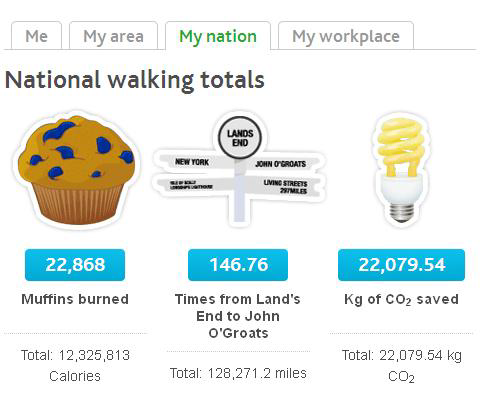 Walk to Work Week is Living Street’s biggest campaign, and is part of National Walking Month, their annual campaign to get everyone walking more each May. I met with Rosie Downes – the Campaigns and Communications Manager at Living Streets – to find out more. I’ve explained here what they did at each of the six stages of an effective sport and activity marketing campaign.
Walk to Work Week is Living Street’s biggest campaign, and is part of National Walking Month, their annual campaign to get everyone walking more each May. I met with Rosie Downes – the Campaigns and Communications Manager at Living Streets – to find out more. I’ve explained here what they did at each of the six stages of an effective sport and activity marketing campaign.
Planning
Audience – They primarily focused on 25-45 year old women in sedentary occupations, which is the group they get the best response from. This is mostly Helenas and Alisons, with some Paulas and Jackies.
Objectives – They wanted to get as many people walking as possible, with a high percentage of them registering for more information from Living Streets in the future. They also wanted to improve on the results they got from the year before.
Activities to promote – In spite of its name, the campaign isn’t just about walking to work. It also wants to encourage any kind of workplace-related walking, whether it’s lunchtime walks, walking meetings or walking home at the end of the day. And even if people live too far from work to walk the whole way, they can still think about walking as part of their journey.
Messages – Whilst there are obvious links to how walking can help you burn calories and lose weight, the campaign also encourages people to think about all the other benefits they can get from walking more. This includes saving money on travel, getting to socialise more with colleagues, and learning more about their streets – maybe discovering some local hidden treasures they never knew were there. They tried hard to make sure they weren’t preaching to people and making them feel guilty about not doing it, but instead focused on the benefits.
Set up
Ways for people to register – This was nearly all done online. Their main Walk to Work Week page drives you to their registration page.
Tracking who’d registered – They used an email marketing system to track who’d registered and needed staying in touch with.
Recruit
Partners – To get the message out they worked with 3rd sector partners such as the British Heart Foundation, MIND, PCTs and councils. In private companies they focused on people working in HR or CSR (Corporate Social Responsibility) departments, who were happy to promote the scheme multiple times.
Email – They also bought lists of public sector staff to email directly.
They’ve found that individuals don’t tend to take part again from one year to the next. This sometimes relates to workplaces focusing on a different health or sustainability topic each year.
Using these methods they got 6,000 people to register in 2012.
Intervene
Once someone’s registered Living Streets send a series of follow up emails starting on April 8th. At first they’re sent weekly, then three emails are sent during Walk to Work Week itself. They also update their Facebook and Twitter pages every day.
During Walk to Work Week, participants are encouraged to:
- see how many miles they walk, calories they burn and carbon they save with Living Street’s online walking calculator
- count all their walking, whether it’s to work, at lunch or for a meeting
- set up teams to compete with colleagues
- achieve a walking feat – either simple individual feats or more extravagant team-feats
- raise money for their favourite charity
Living Streets have also added in some gamification, with badges and prizes from sponsors for achieving certain feats.
Active Participation
Here’s the overall amount of walking done in National Walking Month 2012, of which Walk to Work is the biggest part.
In total 16,000 people took part (the 6,000 who signed up for updates, and 10,000 more who didn’t). The total walking logged as part of Walk to Work week and the other National Walking Month campaigns came to 128,271.2 miles.
Review
Living Streets carries out follow-up surveying with Walk to Work Week participants 5-6 months after the event to evaluate the longer-term impact the campaign has had on their walking levels. Following the 2012 event, they found that:
- The percentage of respondents achieving the recommended levels of 30 minutes of physical activity on 5 or more days per week rose from 42% to 51%
- The percentage of respondents walking for some or their entire journey to or from work 5 days per week increased from 26% to 47%
- The number of respondents who walked at or during work 5 days a week increased from 30% to 47% as a result of the campaign.
- Since participating in Walk to Work Week, 50% of respondents felt that their overall level of walking had increased.
- The percentage of people travelling by car or van decreased by 6%
- Many respondents stated that they felt fitter, healthier and more active when asked how they felt after taking part in Walk to Work Week.
Living Streets also use emails to stay in touch with participants and run mini-campaigns promoting their mince pie calculator and ice cream calculator, which encourage people to walk more to burn off the calories from their naughty treats.
Get involved
Find out more about Walk to Work Week 2013, download free promotional resources and sign up.: www.livingstreets.org.uk/walktoworkweek.
Learn more about running your own campaign
If you want more information about how to run sport and activity marketing campaigns then check out our free introductory guide to marketing sport and activity.

